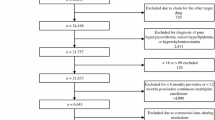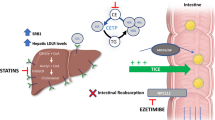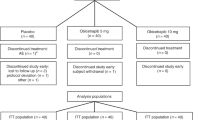Abstract
Background
Colesevelam is a bile acid sequestrant that differs structurally from traditional bile acid sequestrants, allowing it to bind bile acids with greater affinity. Studies have shown that colesevelam significantly reduces low-density lipoprotein cholesterol (LDL-C) levels and, in some cases, significantly increases high-density lipoprotein cholesterol (HDL-C) levels in adults with primary hypercholesterolemia.
Objective
To investigate the safety and efficacy of colesevelam in adults with primary hypercholesterolemia.
Study Design
This multicenter, open-label, titration-based extension study enrolled subjects who completed one of three multicenter, randomized, double-blind, placebo-controlled phase II studies with colesevelam. This study consisted of a 4-week washout/dietary stabilization period, a 50-week open-label treatment period, and a 2-week follow-up period.
Setting
Ten clinical centers within the US.
Subjects
Males and females 18 years of age or older who had completed a previous short-term (4- or 6-week) phase II clinical study with colesevelam.
Intervention
At week 0 (following a 4-week washout of all lipid-lowering medication), subjects initiated treatment with colesevelam at a dosage of 1.5 g/day. Colesevelam was uptitrated to a maximum dosage of 3.75 g/day as necessary to achieve a 15–30% reduction from baseline in LDL-C level. At week 12, an HMG-CoA reductase inhibitor (statin) or niacin (nicotinic acid) could be added if colesevelam 3.75 g/day was not sufficient to result in a 15–30% reduction from baseline in LDL-C level.
Main Outcome Measure
The primary efficacy measure was the change in LDL-C level from baseline to week 50 across all treatment regimens. Secondary efficacy parameters included the change and percent change in total cholesterol, HDL-C, and triglyceride levels from baseline to week 50. There were three cohorts analyzed: (i) colesevelam monotherapy (included all subjects who received colesevelam monotherapy, regardless of dose); (ii) all treatment regimens (included all subjects who received colesevelam monotherapy or colesevelam plus low-dose statin or niacin therapy); and (iii) combination therapy (included only subjects who received colesevelam plus low-dose statin therapy). Two additional cohorts were also evaluated: (iv) maximum-dose colesevelam monotherapy (included only subjects who received colesevelam 3.75 g/day monotherapy); and (v) all maximum-dose colesevelam treatment regimens (included all subjects who received colesevelam 3.75 g/day, either as monotherapy or in combination with low-dose statin or niacin therapy).
Results
In total, 272 subjects were screened, 260 enrolled, and 186 completed the study. In total, 255 subjects were included in the intent-to-treat population. The maximum dosage of colesevelam (3.75 g/day) was taken by 50% of subjects (n = 94/188) at week 50; only 38 subjects received low-dose statin or niacin by study end. At week 50, LDL-C levels were significantly (p < 0.001) reduced from baseline across all treatment regimens (by 29.6 mg/dL [from 185.8 to 156.2 mg/dL; 15.0%]). Colesevelam also significantly reduced total cholesterol levels and significantly increased HDL-C and triglyceride levels across all treatment regimens (p <0.001 for all). Drug-related adverse events were reported by 36.2% of subjects across all treatment regimens (and by 47.4% of subjects who received colesevelam plus low-dose statin or niacin therapy).
Conclusion
In this study, colesevelam was found to be safe and effective for the management of LDL-C levels in adults with primary hypercholesterolemia.








Similar content being viewed by others
References
NCEP ATP III. Third Report of the National Cholesterol Education Program (NCEP) Expert Panel on Detection, Evaluation, and Treatment of High Blood Cholesterol in Adults (Adult Treatment Panel III) final report. Circulation 2002 Dec 17; 106(25): 3143–421.
Wilson PW, D’Agostino RB, Levy D, et al. Prediction of coronary heart disease using risk factor categories. Circulation 1998 May 12; 97(18): 1837–47.
Kannel WB, Neaton JD, Wentworth D, et al. Overall and coronary heart disease mortality rates in relation to major risk factors in 325,348 men screened for the MRFIT. Multiple Risk Factor Intervention Trial. Am Heart J 1986 Oct; 112(4): 825–36.
Stamler J, Wentworth D, Neaton JD. Is relationship between serum cholesterol and risk of premature death from coronary heart disease continuous and graded? Findings in 356,222 primary screenees of the Multiple Risk Factor Intervention Trial (MRFIT). JAMA 1986 Nov 28; 256(20): 2823–8.
The Lipid Research Clinics Coronary Primary Prevention Trial results: II. The relationship of reduction in incidence of coronary heart disease to cholesterol lowering. JAMA 1984 Jan 20; 251(3): 365–74.
The Lipid Research Clinics Coronary Primary Prevention Trial results: I. Reduction in incidence of coronary heart disease. JAMA 1984 Jan 20; 251(3): 351–64.
Pekkanen J, Linn S, Heiss G, et al. Ten-year mortality from cardiovascular disease in relation to cholesterol level among men with and without preexisting cardiovascular disease. N Engl J Med 1990 Jun 14; 322(24): 1700–7.
Rossouw JE, Lewis B, Rifkind BM. The value of lowering cholesterol after myocardial infarction. N Engl J Med 1990 Oct 18; 323(16): 1112–9.
Wong ND, Wilson PW, Kannel WB. Serum cholesterol as a prognostic factor after myocardial infarction: the Framingham Study. Ann Intern Med 1991 Nov 1; 115(9): 687–93.
Insull Jr W. Clinical utility of bile acid sequestrants in the treatment of dyslipidemia: a scientific review. South Med J 2006 Mar; 99(3): 257–73.
Shepherd J, Packard CJ, Bicker S, et al. Cholestyramine promotes receptormediated low-density-lipoprotein catabolism. N Engl J Med 1980 May 29; 302(22): 1219–22.
Bays H, Dujovne C. Colesevelam HCl: a non-systemic lipid-altering drug. Expert Opin Pharmacother 2003 May; 4(5): 779–90.
Braunlin W, Zhorov E, Smisek D, et al. In vitro comparison of bile acid binding to colesevelam HCl and other bile acid sequestrants. Polymer Reprints 2000; 41: 708–9.
Davidson MH, Dillon MA, Gordon B, et al. Colesevelam hydrochloride (cholestagel): a new, potent bile acid sequestrant associated with a low incidence of gastrointestinal side effects. Arch Intern Med 1999 Sep 13; 159(16): 1893–900.
Davidson MH, Toth P, Weiss S, et al. Low-dose combination therapy with colesevelam hydrochloride and lovastatin effectively decreases low-density lipoprotein cholesterol in patients with primary hypercholesterolemia. Clin Cardiol 2001 Jun; 24(6): 467–74.
Hunninghake D, Insull Jr W, Toth P, et al. Coadministration of colesevelam hydrochloride with atorvastatin lowers LDL cholesterol additively. Atherosclerosis 2001 Oct; 158(2): 407–16.
Bays HE, Davidson M, Jones MR, et al. Effects of colesevelam hydrochloride on low-density lipoprotein cholesterol and high-sensitivity C-reactive protein when added to statins in patients with hypercholesterolemia. Am J Cardiol 2006 Apr 15; 97(8): 1198–205.
Moore A, Phan BAP, Challender C, et al. Effects of adding extended-release niacin and colesevelam to statin therapy on lipid levels in subjects with atherosclerotic disease. J Clin Lipidol 2007; 1(6): 620–5.
National Cholesterol Education Program (NCEP) step 1 diet [online]. Available from URL: http://www.americanheart.org/presenter.jhtml?identifier=4764 [Accessed 2010 Aug 5].
Dobs AS, Prasad M, Goldberg A, et al. Changes in serum lipoprotein(a) in hyperlipidemic subjects undergoing long-term treatment with lipid-lowering drugs. Cardiovasc Drugs Ther 1995 Oct; 9(5): 677–84.
Brunzell JD, Davidson M, Furberg CD, et al. Lipoprotein management in patients with cardiometabolic risk: consensus conference report from the American Diabetes Association and the American College of Cardiology Foundation. J Am Coll Cardiol 2008 Apr 15; 51(15): 1512–24.
Acknowledgments
This study was sponsored by GelTex Pharmaceuticals, Inc. and was carried out between November 1996 and October 1998. In 2000, GelTex Pharmaceuticals, Inc. was acquired by Genzyme General, a division of Genzyme Corporation. Daiichi Sankyo, Inc. markets colesevelam hydrochloride (Welchol®). Medical writing services and editorial assistance provided by Karen Stauffer, PhD, of inScience Communications, a Wolters Kluwer business, were funded by Daiichi Sankyo, Inc. Although M.H. Davidson has received grant/research support and honorarium, and served as a consultant/speaker for several pharmaceutical companies, these have no influence or validity on the information provided in this study. J.M. Donovan is an employee of Genzyme Corporation, and S. Misir and M.R. Jones are employees of Daiichi Sankyo, Inc.
Author information
Authors and Affiliations
Corresponding author
Rights and permissions
About this article
Cite this article
Davidson, M.H., Donovan, J.M., Misir, S. et al. A 50-Week Extension Study on the Safety and Efficacy of Colesevelam in Adults with Primary Hypercholesterolemia. Am J Cardiovasc Drugs 10, 305–314 (2010). https://doi.org/10.2165/11584310-000000000-00000
Published:
Issue Date:
DOI: https://doi.org/10.2165/11584310-000000000-00000




